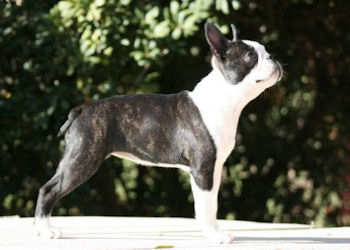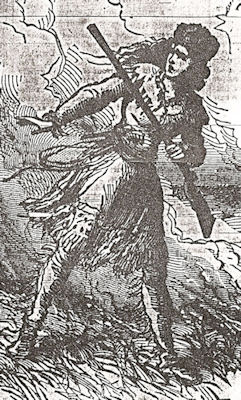Breeders of Awesome Performance Boston Terriers
Brandy's Hurricane Nell

 Expected birth but not expected alive at 55 days of age, Nell is a myth like her namesake: a victorious survivor!
Expected birth but not expected alive at 55 days of age, Nell is a myth like her namesake: a victorious survivor!
Hurricane Nell made her first appearance in 1878. She was an early example of the "woman in jeopardy" theme. Nell was persecuted by a ruffian, Bob Woolf, who set fire to her home and hastened her parents' death. She sought vengeance and after a spell reappeared in Colorado mining settlements wearing men's clothing and able to "outrun, out-ride, out-shoot, out-lasso, and out-yell" any man in town. Not that Wheeler let this strong-arm stuff obliterate Nell's femininity -- she was also beautiful with lustrous eyes that had a soft, dreamy, wistful expectancy when she looked at the hero.
Hurricane Nell, the Girl Dead-Shot or The Queen of the Saddle and Lasso, was the first published novel of Edward Lytton Wheeler, author of dime novels in the 1870's and 1880's. Hurricane Nell, a fictional woman, was the prototype for his Calamity Jane stories. It is not uncommon for authors to use names of actual western figures, but events in the dime novels usually were fictional.
In Ned Buntline's Bob Woolf, the Border Ruffian; or, the Girl Deadshot, a knowledgeable innkeeper says of Hurricane Nell, "Her whole life is dedicated to the one terrible object, revenge. She roams through the wilderness in various disguises, and every few weeks some one finds a dead outlaw, wi' her death mark upon him . . . . She comes and goes at will. No one dares to cross her path. She is a modest and pleasant companion, to those she fancies, but to her enemies she is an actual terror. Why, sir, once I seen her shoot a feller, in yonder, just for forcibly kissin' an Indian girl, 'ginst her will." Hurricane Nell, as a victim of sexual violence herself, is clearly sensitive on this point.
The transference of the skills and functions of the Wild Western hero to a woman, the use of the theme of revenge to motivate violence, and the promotion of the Amazon to full status as a heroine are all exemplified in Edward L. Wheeler's Hurricane Nell, who appeared in 1878 almost simultaneously with the first appearance of Deadwood Dick. At the opening of the story Nell is the conventional distressed female, victim of the ruffian Bob Woolf's cruelty in firing her house and hastening the death of her parents. She swears the customary oath of vengeance and reappears after a time in the Pike's Peak mining towns wearing men's clothing, a mistress of all the accomplishments of the Wild West. She can "outrun, out-ride, out-shoot, out-lasso, and out-yell" any man in town. When the hero, a handsome Philadelphia lawyer, hires her as a guide, she lassoes a mustang for him and rescues him from the Indians in a scene that reverses a vast tradition. As the hero's horse tires, Hurricane Nell seizes the man about the waist, raises him high overhead "by the power of her wonderful arms," and deposits him on the back of the wild stallion. She also kills three men with three shots from her rifle. The heroine's assumption of the functions of the Leatherstocking type is complete when the hero bets a thousand dollars on her skill in a shooting match and she wins.
The tendency to make the Amazon athletic might seem likely to detract from her feminine charms, but Wheeler does not mean to surrender this source of interest. He takes pains to make Hurricane Nell overwhelmingly beautiful, gives to her lustrous eyes a soft, dreamy, wistful expectancy when she looks at the hero, and indulges in a touch of sadism by having her dangled over a fire by her torturers.
After long years of trials and suffering, Hurricane Nell and her father are reunited and, by God's kind beneficence, been permitted to emerge from the cloud of wrong, hatred and vengeance, into the pure freedom and peace of reunion and better existence.
